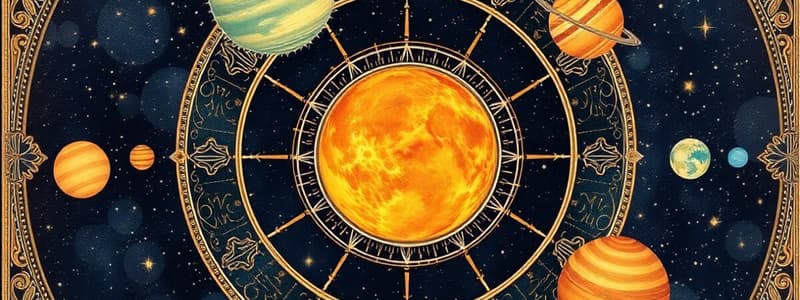Podcast
Questions and Answers
What is the primary component of the Solar System by mass?
What is the primary component of the Solar System by mass?
- The moons
- The planets
- The Sun (correct)
- Asteroids
What characterizes the inner planets of the Solar System?
What characterizes the inner planets of the Solar System?
- They are smaller and composed mostly of rock and metal. (correct)
- They have many moons and rings.
- They are primarily made of gas.
- They orbit farthest from the Sun.
How far is one astronomical unit (AU) approximately?
How far is one astronomical unit (AU) approximately?
- 1 billion km
- 50 million km
- 150 million km (correct)
- 300 million km
What led to Pluto's change in classification as a planet in 2006?
What led to Pluto's change in classification as a planet in 2006?
Which of the following planets is classified as a Jovian planet?
Which of the following planets is classified as a Jovian planet?
What makes up the rings of the outer planets?
What makes up the rings of the outer planets?
Which feature is characteristic of the Earth’s shape?
Which feature is characteristic of the Earth’s shape?
Which of the following galaxies is associated with our Solar System?
Which of the following galaxies is associated with our Solar System?
What is a common characteristic of Jovian planets compared to terrestrial planets?
What is a common characteristic of Jovian planets compared to terrestrial planets?
Which object is not considered an inner planet?
Which object is not considered an inner planet?
Flashcards
Solar System
Solar System
The Sun and all the objects that orbit it, including planets, moons, asteroids, and comets.
Astronomical Unit (AU)
Astronomical Unit (AU)
The average distance from Earth to the Sun (approximately 150 million km).
Inner Planets
Inner Planets
Planets closest to the Sun; they are mostly rock and metal, smaller, and have few or no moons.
Outer Planets
Outer Planets
Signup and view all the flashcards
Galaxy
Galaxy
Signup and view all the flashcards
Milky Way
Milky Way
Signup and view all the flashcards
Planet
Planet
Signup and view all the flashcards
Earth's Shape
Earth's Shape
Signup and view all the flashcards
Earth's Mean Radius
Earth's Mean Radius
Signup and view all the flashcards
Earth's Circumference (equator)
Earth's Circumference (equator)
Signup and view all the flashcards
Study Notes
Our Solar System
- Composed of the Sun and all objects orbiting it, including planets, moons, rocks, ice, and dust.
- Located near the edge of the Milky Way galaxy.
- The Milky Way is a large, disc-shaped galaxy containing numerous stars held together by gravity.
- Stars vary in size, shape, and density.
- The Sun accounts for 99% of the solar system's mass.
- One astronomical unit (AU) is the average distance from Earth to the Sun (approximately 150 million km).
Planets
- Planets are large, spherical objects orbiting the Sun.
- They revolve around the Sun in specific paths.
- Planets rotate on their axis.
- There are eight planets in our solar system, categorized into inner and outer planets.
Inner Planets
- Primarily composed of rock and metal.
- Smaller in size compared to outer planets.
- Fewer moons or no moons at all.
- Tend to rotate slower on their axes than outer planets.
- Examples include Mercury, Venus, Earth, and Mars.
Outer Planets
- Primarily composed of hydrogen and helium.
- Larger in size than inner planets.
- More moons than inner planets.
- Examples include Jupiter, Saturn, Uranus, and Neptune.
Pluto
- Discovered in 1930.
- Reclassified as a dwarf planet in 2006 by the International Astronomical Union.
- Does not have moons.
Earth
- Shape is a spheroid (sphere flattened at the poles).
- Mean radius: 6371 km
- Circumference at the equator: 40,075 km.
Studying That Suits You
Use AI to generate personalized quizzes and flashcards to suit your learning preferences.




